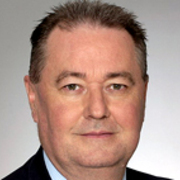
Shaun Brown
Though the majority of English-born Shaun Brown’s working life has been in broadcast journalism, his first taste was in print. He joined the Kent and Sussex Courier in 1966 as a trainee, staying on until 1969. It was a move to Australia in 1970 that first introduced him to broadcasting. He joined the ABC as a reporter in Perth, before moving to Auckland and a newspaper reporting job for the NZ Herald.
In 1972 it was back to broadcasting when he joined what was then the NZBC as a reporter on the Network News, later taking roles in Tonight at Nine and the more current affairs-oriented Dateline Monday.
It was during this time that Brown became involved in one of the iconic events in New Zealand’s nuclear free campaign. In 1973 Norman Kirk’s Labour government decided to send the frigates HMNZS Otago and Canterbury to the French nuclear testing site at Mururoa Atoll as a symbolic protest (Kirk's arguments for the action can be seen in this interview with David Frost). Brown volunteered to travel on the Otago and was one of only five people on the bridge of the warship when a nuclear device was detonated in an atmospheric test.
“Wearing protective goggles and anti-flash clothing we turned our backs on Mururoa as the official French countdown came over the Otago's radio,” he reported. “As the countdown ended there was a brief flash and then nothing. But then the Captain of the Otago, Commander Alan Tyrrell, sighted the fireball rising from behind a layer of clouds. Within seconds the grey stalk caused by the rising fireball had been topped by a mushroom cloud which climbed higher and higher.”
In 2002 Brown, along with others aboard the flotilla, was awarded the newly created New Zealand Special Service Medal (Nuclear Testing) in recognition of his participation.
During this period Brown also completed the NZBC Producers Course and, in 1977, the Australian Film and Television Academy Documentary Producers Course. He also worked for a time as a sports producer.
Between 1979 and 1980 Brown returned to the UK for a stint with the BBC. There he joined Kiwi Paul Norris on the production team that launched the experimental programme, Newsnight. It’s now established as a touchstone of BBC news and current affairs output.
Returning to New Zealand in 1981 Brown became a producer with Fair Go before taking on the role of editor of Eyewitness News, designing and launching the nightly news and current affairs programme.
From between 1983 and 1988 Brown formed his own company, Shaun Brown Ltd, producing and directing documentaries and acting as a media commentator on TVNZ’s Fourth Estate.
In 1988 he returned to TVNZ as Editor of daily news programmes, and from 1990 to 1994 Deputy Managing Editor, News & Current Affairs. These were challenging times for TVNZ. In 1989, and for the first time, the state broadcaster faced genuine competition. TV3 launched that year and Brown had to prepare the news division for a more aggressive market.
One News was re-launched and the nightly current affairs show Holmes appeared on Kiwi screens. This was a significant departure from the old style of state broadcasting. He also pushed through the introduction of so-called 'one-man bands' (one person news crews with the camera operator also handling sound), a move that met some resistance from unions and staff. At the same time, TVNZ established foreign bureaux in London and Sydney and introduced live coverage capability within News.
In November 1994 Brown succeeded Paul Norris as Managing Editor, News and Current Affairs. Over the next three years he created and implemented the 'Round the Clock' news strategy on TV One. Weeknight editions of One News were expanded to a full hour and One News at Midday, Telstra Business at 6.30am and the Breakfast programme between seven and nine am were added to the channel’s output. Full hour bulletins at weekends and an early bulletin at six am were also added.
In 1996 Brown initiated and oversaw the development of a computerised and automated Election Night programme with enhanced graphics capability. He produced the full programme on the night, including taking all the editorial and coverage decisions. His efforts were rewarded with the Qantas Media Award for Best Producer and the Overall Qantas Award for Best Application of the Television Medium to Journalism.
In 1997 he took over additional responsibility for Sport and later that year was appointed Head of TV One. During the next four years he made the channel profitable for the first time and completed a re-negotiation of Olympic Games rights with the International Olympic Committee.
In 2001 Brown was appointed TVNZ’s Head of Television, a position he held until 2002 when he moved to Australia. There he took on the role of Head of Television at Special Broadcasting Service, or SBS. There his strategies increased Australian content and audience share. He was also instrumental in acquiring the rights to the Athens Olympics, the Ashes in 2005 and 2009, and the FIFA World Cup in 2006, 2010 and 2014.
He became Managing Director of SBS in 2006, overseeing the launch of a second channel, SBS Two.
Shaun Brown retired in June 2011, having lived through, and sometimes overseen, some of the biggest changes in Australasian broadcasting.
Sources include
Shaun Brown